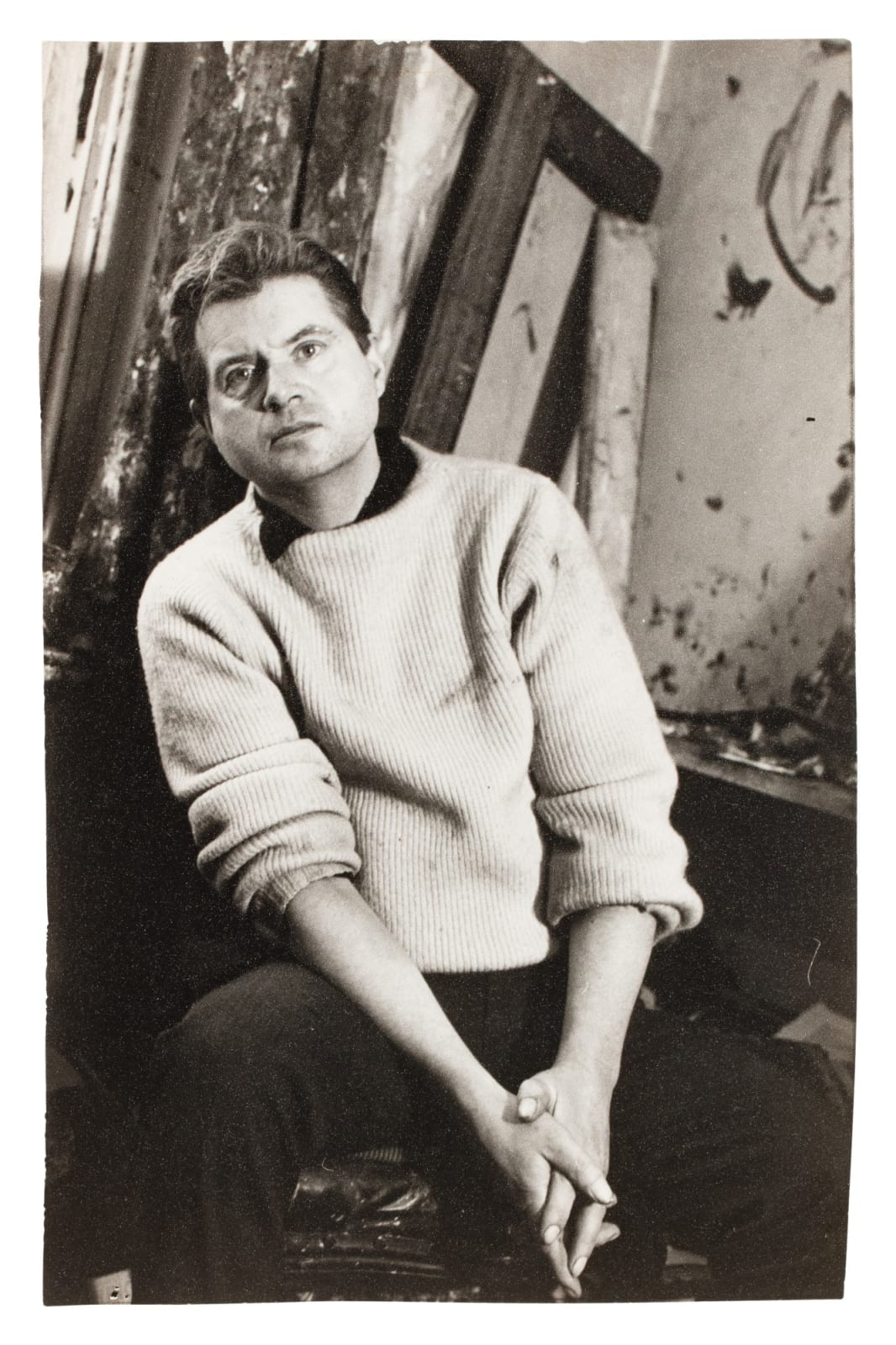Cecil Beaton
Francis Bacon in his Battersea studio, 1960
silver print
8 1/4 x 5 1/4 in
21 x 13.5 cm
21 x 13.5 cm
photographer's stamp verso
Beaton and Bacon were kindred artistic spirits and enjoyed each other's company, sometimes spent drinking together in Soho. This photograph is from a series shot in Bacon’s Battersea studio in...
Beaton and Bacon were kindred artistic spirits and enjoyed each other's company, sometimes spent drinking together in Soho. This photograph is from a series shot in Bacon’s Battersea studio in January 1960, and captures the artist at the age of 50. In his journals Beaton evocatively described Bacon's studio as 'a Dostoevsky shambles of discarded paints, rags, newspapers and every sort of rubbish'.
"The social milieu of Bacon and Cecil Beaton coincided at various points in the 1950s. Hence, Beaton photographed Bacon as early as 1951, when he was a guest at Reddish House, Beaton's elegant country home in Wiltshire. In these photographs, Bacon is smartly dressed, while in the series Beaton made in 1960, in the small room that served as Bacon's studio in Overstrand Mansions, Battersea, although Bacon is posing for the camera rather than working, he is more casually attired. Shortly afterwards, Bacon reciprocated by painting Beaton's portrait in the same studio. Beaton, unrealistically expecting to be flattered, was horrified at the way he had been depicted, and conveyed his disappointment to Bacon, whereupon Bacon gleefully destroyed the painting – to Beaton's eventual regret."
MARTIN HARRISON, IN FRANCIS BACON: STUDY FOR A PORTRAIT, 2019, p8
"In September 1955, Bacon found a six-year respite from his wanderings, and upheavals caused by his lover Peter Lacy, when, at the request of his frame maker and friend Alfred Hecht, Peter Pollock and Paul Danquah offered him a living and working space in their apartment at 9 Overstrand Mansions, Prince of Wales Drive, Battersea. The small room that served as Bacon's studio was brilliantly photographed in 1957 and 1960 by Douglas Glass. The images revealed the youthful-looking artist, then in his late forties, in his working quarters, often surrounded by his most recent paintings. The studio had a look of abandon and chaos: magazines, books, newspapers, brushes, palettes cluttered the floor and paint was spattered over the furniture, curtains and walls. The self-taught painter explained in various interviews how he felt at home in such chaos, and how chaos bred images for him. In sharp contrast with the pristine Bauhaus order of his early decorator's studio at Queensberry Mews, his messy working quarters nourished his imagination and became the kind of environment where he worked best. The iconic British photographer Cecil Beaton similarly captured Bacon's Overstrand Mansions studio in a long series of shots taken in 1960, describing it as 'a Dostoevsky shambles of discarded paints, rags, newspapers and every sort of rubbish, while the walls and window curtains were covered with streaks of black and emerald green paint. (Richard Buckle (ed.), Self-Portrait with Friends, The Selected Diaries of Cecil Beaton 1922-74 (New York: Times Books, 1979), p. 322)"
MAJID BOUSTANY IN 'FRANCIS BACON: STUDIOS', MONACO, 2021, p11
"The social milieu of Bacon and Cecil Beaton coincided at various points in the 1950s. Hence, Beaton photographed Bacon as early as 1951, when he was a guest at Reddish House, Beaton's elegant country home in Wiltshire. In these photographs, Bacon is smartly dressed, while in the series Beaton made in 1960, in the small room that served as Bacon's studio in Overstrand Mansions, Battersea, although Bacon is posing for the camera rather than working, he is more casually attired. Shortly afterwards, Bacon reciprocated by painting Beaton's portrait in the same studio. Beaton, unrealistically expecting to be flattered, was horrified at the way he had been depicted, and conveyed his disappointment to Bacon, whereupon Bacon gleefully destroyed the painting – to Beaton's eventual regret."
MARTIN HARRISON, IN FRANCIS BACON: STUDY FOR A PORTRAIT, 2019, p8
"In September 1955, Bacon found a six-year respite from his wanderings, and upheavals caused by his lover Peter Lacy, when, at the request of his frame maker and friend Alfred Hecht, Peter Pollock and Paul Danquah offered him a living and working space in their apartment at 9 Overstrand Mansions, Prince of Wales Drive, Battersea. The small room that served as Bacon's studio was brilliantly photographed in 1957 and 1960 by Douglas Glass. The images revealed the youthful-looking artist, then in his late forties, in his working quarters, often surrounded by his most recent paintings. The studio had a look of abandon and chaos: magazines, books, newspapers, brushes, palettes cluttered the floor and paint was spattered over the furniture, curtains and walls. The self-taught painter explained in various interviews how he felt at home in such chaos, and how chaos bred images for him. In sharp contrast with the pristine Bauhaus order of his early decorator's studio at Queensberry Mews, his messy working quarters nourished his imagination and became the kind of environment where he worked best. The iconic British photographer Cecil Beaton similarly captured Bacon's Overstrand Mansions studio in a long series of shots taken in 1960, describing it as 'a Dostoevsky shambles of discarded paints, rags, newspapers and every sort of rubbish, while the walls and window curtains were covered with streaks of black and emerald green paint. (Richard Buckle (ed.), Self-Portrait with Friends, The Selected Diaries of Cecil Beaton 1922-74 (New York: Times Books, 1979), p. 322)"
MAJID BOUSTANY IN 'FRANCIS BACON: STUDIOS', MONACO, 2021, p11
Provenance
Valerie Beston, London
Private Collection
Private Collection, Paris, acquired from the above
Literature
Majid Boustany, Francis Bacon MB Art Foundation, Monaco, 2017, p18, illus colourJoin our mailing list
* denotes required fields
We will process the personal data you have supplied to communicate with you in accordance with our Privacy Policy. You can unsubscribe or change your preferences at any time by clicking the link in our emails.
